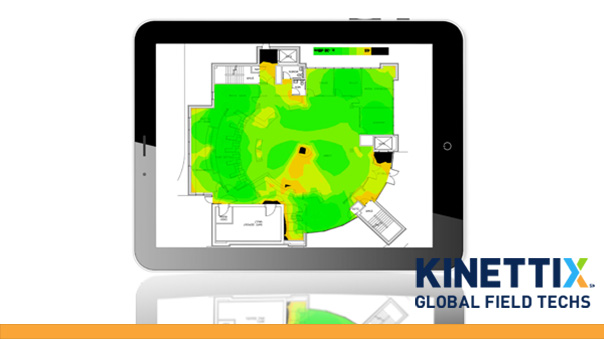In our modern business environment, strong, stable internet coverage is an absolute necessity. Wireless site surveys are crucial component for ensuring the optimal network performance your workplace needs. These surveys help in identifying the best locations for access points, diagnosing connectivity issues, and designing robust wireless networks. There are three primary types of wireless site surveys: Active Site Surveys, Passive Site Surveys, and Predictive Site Surveys. Each type serves a unique purpose and is suitable for different scenarios. This blog post delves into these three types of wireless surveys, their benefits, and when to use them.
1. Active Site Surveys
What Are Active Site Surveys?
Active Site Surveys involve actively sending and receiving data packets over the network to measure performance metrics such as throughput, latency, packet loss, and signal strength. This type of survey involves using a Wi-Fi adapter to associate with access points and perform real-time data transmission tests. The survey collects data from multiple locations within the site to give a comprehensive view of the network's performance.
Benefits of Active Site Surveys
- Real-Time Performance Metrics: Active Site Surveys provide real-time data on network performance, which is essential for identifying issues like low throughput, high latency, and packet loss.
- User Experience Simulation: By actively transmitting data, these surveys simulate actual user experiences, making them invaluable for assessing network performance under real-world conditions.
- Detailed Analysis: The data collected during Active Site Surveys allows for a detailed analysis of network performance, helping to pinpoint specific areas that require improvement.
When to Use Active Site Surveys
- Post-Deployment Verification: After installing a new wireless network, an Active Site Survey can verify that the network meets performance expectations and identify any areas that may need adjustments.
- Troubleshooting: When users report connectivity issues, an Active Site Survey can help diagnose the problem by providing detailed performance metrics.
- Capacity Planning: For environments with varying user loads, such as conference centers or stadiums, Active Site Surveys can help plan for capacity and ensure consistent performance during peak usage times
2. Passive Site Surveys
What Are Passive Site Surveys?
Passive Site Surveys involve passively listening to the signals from existing access points without actively transmitting data. A surveying device, such as a laptop with specialized software, captures information about signal strength, noise levels, and access point coverage as it moves through the survey area. This type of survey does not require any interaction with the network and focuses solely on the radio frequency (RF) environment.
Benefits of Passive Site Surveys
- Comprehensive RF Analysis: Passive Site Surveys provide a detailed view of the RF environment, including signal strength, interference sources, and channel utilization.
- Non-Intrusive: Since no data is transmitted during the survey, it does not interfere with the existing network, making it ideal for environments where minimal disruption is essential.
- Baseline Assessment: These surveys are excellent for establishing a baseline of the current RF environment, which can be used for future comparisons and troubleshooting.
When to Use Passive Site Surveys
- Initial Network Design: Before deploying a new wireless network, a Passive Site Survey can help design the network by identifying optimal access point locations and potential interference sources.
- Periodic Audits: Regular Passive Site Surveys can help maintain network performance by identifying changes in the RF environment, such as new sources of interference or changes in signal strength.
- Compliance and Security: For environments with strict compliance and security requirements, Passive Site Surveys can help ensure that the network meets regulatory standards and identify unauthorized access points.
3. Predictive Site Surveys
What Are Predictive Site Surveys?
Predictive Site Surveys, also known as virtual or desktop surveys, use software simulations to design a wireless network without physically being on-site. These surveys involve inputting a building's floor plan into specialized software, which then uses algorithms to predict the optimal placement of access points based on factors such as wall materials, potential interference sources, and desired coverage areas.
Benefits of Predictive Site Surveys
- Cost-Effective: Predictive Site Surveys are less expensive than on-site surveys since they do not require travel or physical presence.
- Time-Saving: These surveys can be conducted quickly, making them ideal for tight project timelines.
- Early Planning: Predictive Site Surveys allow for early network design and planning, providing a preliminary layout that can be adjusted during on-site validation.
When to Use Predictive Site Surveys
- New Construction Projects: For new buildings or renovations, Predictive Site Surveys provide a head start on network design before the physical space is available for on-site surveys.
- Budget Constraints: When budget constraints limit the ability to conduct on-site surveys, Predictive Site Surveys offer a viable alternative for preliminary network design.
- Initial Planning: During the initial planning stages of a network deployment, Predictive Site Surveys can provide valuable insights into the optimal number and placement of access points.
Conclusion
Understanding the differences between Active Site Surveys, Passive Site Surveys, and Predictive Site Surveys is essential for designing, deploying, and maintaining efficient wireless networks. Each type of survey offers unique benefits and is suitable for different scenarios. By leveraging the right survey type at the right time, IT field services providers like Kinettix can ensure optimal network performance and meet the specific needs of their clients.
At Kinettix, we specialize in conducting comprehensive wireless site surveys tailored to your unique requirements. Whether you need a detailed Active Site Survey for performance verification, a Passive Site Survey for RF analysis, or a Predictive Site Survey for initial network design, our team of experts is here to help. Contact us today to learn more about our wireless site survey services and how we can assist in optimizing your wireless network.





